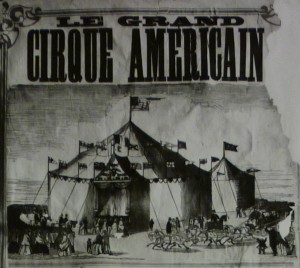Frederic Arthur Bridgman (1847-1928) was an American artist who spent most of his career in France, but is now perhaps best remembered for the “Orientalist” paintings that he made during a series of visits to North Africa. My own curiosity about Bridgman was stimulated after finding a reference to a painting he made of a circus that caused a stir at the Paris Salon of 1870. Bridgman was born in Tuskegee, Alabama and moved to New York City at a young age, where he worked as a draughtsman before departing for France in 1866. In Paris, he studied painting under the tutelage of Jean-Léon Gérôme and adopted his highly finished academic style. Like many other expatriate artists at the time, he traveled to Brittany during the summer and often stayed in Pont-Aven, a coastal town that was fast becoming a significant artist’s colony. Bridgman made of number of paintings during this time depicting rural Breton life, including one that was initially known as Un cirque en province. After debuting at the Paris Salon to wide acclaim, the painting was featured at the Brooklyn Art Association’s Annual exhibition in 1870, where it was again warmly celebrated. In 1875 and now titled The American Circus in France, it was included in the National Academy of Design’s annual exhibition in New York City. It was at this time that the London-based Art Journal commissioned James Geraty to make a steel engraving of the painting, “which last year was the event of the National Academy Exhibition,” for the February 1876 edition of the publication.
It was also around this time that the original painting was sold to a Mr. Edward F. Rook of New York. Per the New York Times, it was subsequently auctioned off by the Fifth-Avenue Art Galleries in April 1888 for the then princely sum of $1,000. Although the buyer was unnamed, the painting later appeared in an exhibition at the Art Institute of Chicago in 1890. However, after that it seemed to have disappeared. Fred Dahlinger and I wanted to use the engraving as an illustration for his essay in the American Circus volume, so we made a concerted effort to find out more about the painting, with marginal success. Part of the problem we had in tracking it was the evolving title, having been variously displayed as Breton Circus, The American Circus in France, American Circus in Paris, A Circus in Brittany, Circus in the Provinces, A Circus in the Province, and American Circus in Normandy. I had actually come to think that the painting had been lost until one of my former students, who is now working at Sotheby’s, casually mentioned the other day that there had been an old American circus painting up for auction last fall. I fairly bolted for a computer and there it was, lot #5 in a 19th Century European Art auction at Sotheby’s this past November!

The painting was estimated at between $250,000-$350,000, but according to the results was either withdrawn or remained unsold. The provenance published by Sotheby’s indicated that Rook’s son was the unnamed buyer at the 1889 auction and revealed that it was subsequently gifted to Nelson C. White in 1960 and passed down through his family. It turns out that we had somehow missed the fact that it was included in a major traveling exhibition about American artists in Brittany and Normandy in the early 1980s, but that seems to have been its only public appearance since 1890. Really I was just happy to see that the painting survives as it is a rather lovely representation of a subject that greatly interests me, namely the American circus abroad.
Of course, much of the secondary literature has speculated about the veracity of the scene. According to Ilene Susan Fort’s dissertation, Bridgman wrote a letter to an unidentified correspondent on February 20, 1871 detailing how he made a model ring and tent using an old sail before going “to a neighboring city to make a study of the whole arrangement of the interior and costumes.” Fort speculates that it was a European troupe, and in his definitive history of the circus in France, La Merveilleuse histoire de cirgue (1947), Henry Thetard reproduced the engraving and described it as an English circus. In all likelihood though, this is an American circus. One obvious clue is the Native American figure sitting with his back to the ring by the bandstand, however, the simple fact that it is a tent circus with a sidewall and center and quarter poles more or less confirms that it is an American one as this was a very characteristic set up. Moreover, an American show managed by James Washington Myers (1820-1892), an all-around circus man who featured as both an equestrian and clown, arrived in France during the spring of 1867. Billing the show as “Le Grand Cirque Americain,” Myers spent the next two years performing in Paris and touring the provinces with an American-style tent circus. Below is a detail of the set-up from a herald in the Musée national des Arts et Traditions Populaires which makes it fairly clear that this was the circus upon which Bridgman modeled his painting.
I will follow up with another post about the classic elements of the circus–ringmaster, equestrians, and clowns–depicted in the painting soon, but I just wanted to highlight Bridgman’s wonderful work and clarify something of its background first.
Sources: For the definitive treatment of Bridgman’s career, see Ilene Susan Fort, “Frederick Arthur Bridgman and the American fascination with the exotic Near East,” (Ph.D. Dissertation, City University of New York, 1990); David Sellin, et. al., Americans in Brittany and Normandy, 1860-1910 (Phoenix Art Museum, 1982); David Fitzroy, Myers’ American Circus (Self-published, 2002).


